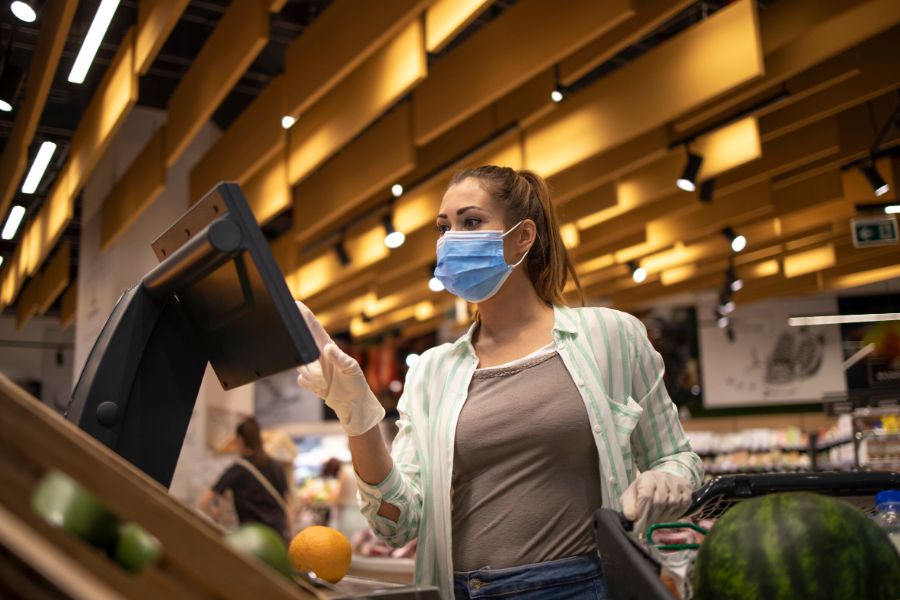2020 is such a truly memorable year for any business industry due to the great COVID-19 impacts on retail market. To prevent the spread of the virus, many countries have imposed temporary closures to restaurants, bars, and venues. Additionally, governments encourage working from home and strictly ban public gatherings. All of these policies have heavily affected the retail market. For example, consumer goods recorded considerable growth due to people stockpiling food while other sectors experienced a drop like clothing, jewelry, and automobiles. At the end of the year, let’s sit back with us and see the numbers that reflect all the shifts in the retail industry.
Influences on the global retail industry
According to Statista, worldwide retail sales dropped by 5.7 percent in 2020 due to the coronavirus crisis. It is said by analysts that grocery and essential consumables still look good while other categories like fashion, beauty, and cosmetics witnessed a fall in customer spending.
Among various product categories, health and hygiene products are purchased more often than usual. The reason is the require of COVID-19 protective measures, such as using hand sanitizer, wearing masks, disinfecting surfaces with alcohol, etc.
At the latest news, every single day records an addition of over 590 thousand cases of COVID-19 worldwide. Therefore, it is projected that global healthcare spending in the next year will continue to rise by 5.8 percent (corresponding to 8.8 trillion US dollars) as IHS Markit research.
Customer behavior has also shifted towards online purchases instead of brick-and-mortar buying. According to Optinmonster, online shopping accounted for 14.1 percent of retail purchases worldwide, which is predicted to rise up to 22 percent in 2023. In particular 2020, the e-commerce market size has hit 4 trillion. It is explained that social distancing and remote working cause people to stay home and order items online.
It is revealed by Statista, online traffic in the supermarket segment is the fastest growing with an increase of 34.8 percent. The follower is the sports equipment sector with 23.6 percent increase in online traffic.
COVID-19 impacts on the US – the largest retail market
Also said by Statistic, even there is no sign that COVID-19 has gone away in the USA, total retail sales in October look positive with a slight rise of 8.5 percent compared to last year. Therein, building material and garden equipment is the most rapid-growing by over 19 percent for two consecutive months. It shows that people still spend much money on house construction and renovation before Christmas and New Year.
Food and beverage have reaped a lot like the building material and garden equipment sector. Throughout 2020, it has always experienced growth and reached a peak of 14.6 percent in May. The reason has been said before that people stock up food and drink due to the COVID impacts.
With that being so, the sales value of consumer goods in multi-purpose stores increased by approximately 10 percent in comparison to 2019. Similar to convenience stores, this figure was roughly 4 percent.
Besides, vegetarian and vegan products are the most preferred products during the coronavirus pandemic. Oat milk and meat substitutes witnessed a massive increase by over 300 percent and 200 percent, in turn.
On the other hand, apparel, jewelry, and out-of-home entertainment such as water parks, zoos, museums, aquariums, etc. are no longer in customers’ favor. The main problem is that these entertainment centers have implemented temporary closures to ensure social distancing. Besides, clothing and accessory stores witnessed a heavy decline of over 50 percent in March compared to the previous month.
Moreover, America’s retail store has been in rough shape due to the virus. 21 percent of US consumers said that they were concerned about going to local stores because of the virus inflection. This results in 8000 retail locations that have shut down permanently, according to Coresight Research.
COVID-19 impacts on Great Britain
As studied by Statistic, total sales volume for September 2020 in Great Britain has experienced a slight increase in non-food stores and household goods compared to February 2020. In lieu of stockpiling food and beverage like US consumers, shoppers in Great Britain have spent copious amounts of money on other things, like cleaning products, cooking items, buckets, toilet tissue, and so forth. That’s the reason why household goods stores reported a significant increase in turnover by 52.4 percent in September 2020.
Similar to the US, the clothing and accessory market in the UK still has not managed to recover from the impact of the virus. Most recent figures display a reduction in retail sales volume for apparel stores that fell at nearly 15 percent in September 2020 compared to February 2020. Also, 65.4 percent of textile clothing and footwear retailers claimed a decrease in turnover in September.
With respect to internet retail sales value in the UK, it has experienced growth throughout this year and skyrockets by 73.4 percent in June compared to the last year. Although clothes have seen a reduction in total sales, it is the most favorite online item with 55 percent. Followings are deliveries from restaurants, fast food chains, or catering service with 32 percent.
Another interesting fact by Comscore is that 44 percent of customers shopped online via smartphones instead of tablets or laptops. This leads to a growing demand for developing mobile apps that are user-friendly and faster-loading speed. At present, store owners can try the PWA app which functions as a normal app and can be delivered in the form of a web.
COVID-19 impacts on other European countries
Germany seems not to be strongly affected by COVID-19, the latest retail sales in October 2020 has grown by 8.2 percent versus the last year. Although, brick-and-mortar stores are required to close due to a contact ban among the population. Even when retail stores were still open, footfall in German shopping streets had fallen dramatically during two weeks in March 2020.
Italian buyers seem to have the same perspective as US consumers when they stock up a lot of food and other types of consumer goods during the complete lockdown in February and March. Ergo, the retail sales value recorded a significant rise of 16.4 percent in March. In addition, online sales registered a growth of 90 percent on March 8th in comparison to the same day of the previous year. According to the latest news, Italy is expected to keep restrictive measures to prevent a third wave of coronavirus during the holiday season.
COVID-19 impacts on China
Like other nations, apparel, jewelry, automobiles, and furniture in China also have hit the hardest in the first two months of 2020 as a report by Statista. Conversely, food, beverage, and medicine have recorded a sales growth of 9.7, 3.1, and 0.2 percent respectively.
In addition, almost 60 percent of the respondents said that they intended to spend more money on medical treatment and 35 percent planned to buy more sports products. It expresses that health issues become a top concern and priority of Chinese consumers during the epidemic.
On the other hand, the recreation sector is estimated to drop 5.8 percent.
In addition to paying for medicine and sports equipment, the Chinese spend a lot of money on customer goods. As a study by the National Bureau of Statistics of China, the total retail sales of customer goods in October rose by 4.3 percent compared to last year. However, this figure for nearly the whole 2020 year (from January to October) showed a decrease of 5.9 percent. It can be explained that clothing, jewelry, and automobiles included in the customer goods have been reduced. As a result, the overall sales value of customer goods has gone down.
According to China Internet Watch, online retail sales from January to November 2020 experienced a year-on-year increase of 11.5 percent. It shows that e-commerce shopping in China is more frequent this year as a result of social distancing.
Advice for retailers during COVID-19 pandemic
Minimize costs and secure your cash flow
The biggest challenges of covid-19 have made many stores close and go bankrupt. To survive in this hardship, you should manage and control your shops’ expenses efficiently.
Let’s keep a close eye on your warehouse and answer these questions. Is it true that you are paying a large number of bucks to hold excess inventory? Are you spending too much on stocking the wrong items? If the answers are yes, you can do several tips to solve the issues. For instance, it is possible to offer sales promotions for slow-moving products and use product performance reports to determine which items are worth stockpiling.
For some businesses, selling on credit is unavoidable. Therefore, your money is tied up in receivables. Let’s make sure that you collect all receivables within the agreed terms. If your customers are unable to pay, you should attempt to directly contact them via emails, phone calls, and even face-to-face.
Another way to implement cost-saving strategies is to lower labor costs. You can consider letting your employees do temporary part-time work. Instead of a complete lay-off, your staff will be more grateful to you for half-pay.
Also, it is possible to cut down on advertising costs. You can practice cost control on both online marketing strategies and in-store advertising. Spendings on posters, flyers, standees, catalogs, etc can be reduced and eliminated. Besides, you can use handy tips to lower the high paid per click (PPC) cost, such as applying geographical targeting.
In the bad cases when you can not pay your bills, make sure you sit down with banks or property owners in the early stages to have a discussion. You can ask for any potential supports or viable solutions. Do not wait until a problem happens, that is too late.
Pay attention to online sales
The above statistics have proved the dizzying development of e-commerce due to the COVID impacts. Ergo, it is better to invest in your online store to increase website traffic and generate more sales. For instance, you probably publish blogs, focus on SEO standards, and speed up your site.
According to the research of Invesp, 71 percent of buyers are more likely to make a purchase based on social media referrals. Apart from your official site, social media is an effective means to engage with customers and boost sales. Let’s be interactive with posts relating to concerns of customers or supportive comments on the buyers’ questions and complaints.
Be flexible and adaptable
COVID-19 has shifted customer behaviors that vary in all geographic areas, from Western to Eastern countries. As a retailer, you should be flexible and adaptable to any changes.
For instance, in-store shopping experience will cause your clients to be fearful of viral infection. Instead of in-store shoppings, you can offer e-commerce and pick up in-store options.
The POS system is designed to facilitate these 2 options. In more detail, the system has a click-and-collect function that allows clients to buy online and collect at the store. In addition, POS supports PWA Consumer Apps that buyers can do self-checkout in seconds. Furthermore, the app enables shoppers to order out-of-stock items and get personalized recommendations.
Moreover, in place of OOH advertising (out-of-home) such as ultra-expensive billboards, you can try to do online marketing. Various digital advertising trends are feasible to implement, like influencer marketing, social media stories, and progressive web apps (PWAs)
On the whole,
It is undeniable that store owners are put under immense pressure during the uncontrollable coronavirus outbreak. As proved by statistics, online retailing has evolved rapidly in 2020 no matter COVID impacts. Therein, customer goods, medical treatment, and sports products have recorded significant growth. Therefore, changes in the epidemic period do not all be negative. All retailers should do is be open-minded and flexible to come up with new strategies for new situations. Feel free to contact us for further information on the retail market and the out-of-box technological solutions for your stores!
►►► See our products: Magento POS, BigCommerce POS, Shopify POS, Woocommerce POS, NetSuite POS, Commercetools POS, Custom POS, White label POS, Customer Experience Solution and Next-Gen POS




